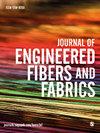用于声学和热学性能的可持续废棉和鸽豆秆纤维复合材料
IF 2.3
4区 工程技术
Q1 MATERIALS SCIENCE, TEXTILES
引用次数: 0
摘要
本研究重点研究了采用压缩成型系统,分别以50/50、70/30、30/70、60/40、100/0废棉和0/100废豌豆秸秆为混纺比例的鸽豆秸秆/棉纤维复合材料的研制与表征。按照美国材料测试协会标准(ASTM),对整个复合材料样品进行声学、热学和物理参数测试。根据ASTME1050标准,采用阻抗管法测量了吸声系数,计算了125、250、500、1000、2000和4000 Hz六个频率上的吸声系数。结果表明,以棉/鸽豆为原料制备的复合材料具有80%以上的SAC,且复合材料具有最佳的保温、吸声、吸湿和纤维性能。结果表明,棉/豌豆秸秆废纤维经声浸处理后的复合材料达到75%以上,废纤维经时尚专用、声浸、湿浸和纤维材料处理后的复合材料达到28%以上。废棉/鸽豆秸秆复合材料在高湿条件下具有良好的抗湿性,且不影响其绝缘性能。本文章由计算机程序翻译,如有差异,请以英文原文为准。
Sustainable waste cotton and pigeon pea stalk fibers composite materials for acoustics and thermal properties
This study focuses on the development and characterization of pigeon pea stalk/cotton fibers mixed with a blend ratio of 50/50, 70/30, 30/70, 60/40, 100/0 waste cotton and 0/100 waste pea stalk composites are equipped with a compression molding system. The entire composite samples are tested for acoustics, thermal and physical parameters as per the American Society for Testing and Materials standard (ASTM). The sound absorption coefficients (SAC) were measured according to ASTME1050 by an impedance tube method, and the SAC over six frequencies 125, 250, 500, 1000, 2000, and 4000 Hz were calculated. The result revealed that the composite samples that are prepared from cotton/pigeon pea waste have confirmed more than 80% of the SAC and the waste composites provided the best insulation, sound absorption, moisture absorption, and fiber properties. The effect exposed that composites materials arranged from cotton/pea stalk waste fiber have established further than 75% by the sound immersion measure and the waste 28% composites handed the fashionable Appropriation, sound immersion, humidity immersion, and fiber materials. The waste cotton/pigeon pea stalk composite samples have satisfactory moisture resistance at high humidity situations without disturbing the insulation properties.
求助全文
通过发布文献求助,成功后即可免费获取论文全文。
去求助
来源期刊

Journal of Engineered Fibers and Fabrics
工程技术-材料科学:纺织
CiteScore
5.00
自引率
6.90%
发文量
41
审稿时长
4 months
期刊介绍:
Journal of Engineered Fibers and Fabrics is a peer-reviewed, open access journal which aims to facilitate the rapid and wide dissemination of research in the engineering of textiles, clothing and fiber based structures.
 求助内容:
求助内容: 应助结果提醒方式:
应助结果提醒方式:


